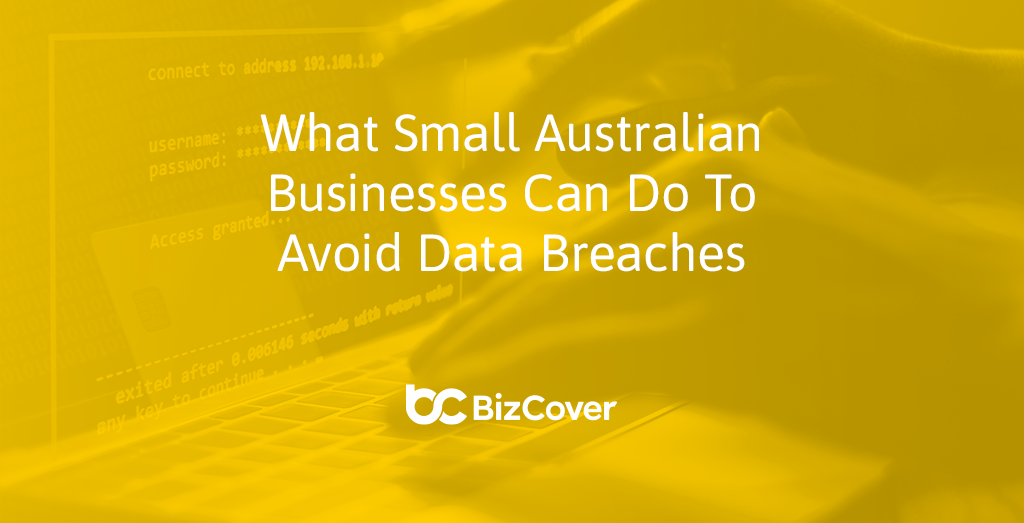How to prevent a data breach in 2025
As data breach incidents continue to make headlines, small businesses find themselves increasingly vulnerable to targeted cyber-attacks.
The Australian Cyber Security Centre* received nearly 94,000 cybercrime reports in the 2023 financial year, an increase of nearly 23% from the year before. That’s one report every six minutes, with the average loss being $46,000 per report for small businesses.
The repercussions of a cyber breach extends far beyond the financial impact. The loss of reputation and trust among their customers is near-permanent when their sensitive information is leaked.
In response, small business owners are actively seeking data breach protection strategies and ways to avoid the consequences of a cyber attack.
This article aims to shed light on the threat of cyber breaches and answer some common questions about data breach mitigation tactics. It will cover:
- How do you define a data breach?
- What causes a data breach?
- How can small business owners mitigate data breaches?
- What protections can you use to safeguard your business from the consequences of a data breach?
What is a data breach?
A data breach is the unauthorised release of confidential information to someone not permitted to see it. Cybercriminals can exploit this data in numerous harmful ways, including spreading it to tarnish a company’s image, committing fraud, or demanding a ransom.
Although a network breach can lead to unauthorised data access, its implications aren’t limited to data breaches alone. It can also disrupt services or enable covert spying on a business without necessarily extracting any information.
This makes data breaches only one outcome of a hacked network.
What causes a data breach?
Despite data breaches becoming more common among Australian businesses, many business owners underestimate the risk and lack protection.
Overall, most data breaches happen for two reasons: technological weaknesses and human error.
Data is transferred and stored across many devices that usually connect through a central system. If these devices are not protected by firewalls or antivirus software, they could be potential avenues for cybercriminals to exploit.
Australian small businesses spend little on cyber security compared to the risk it presents, with 48% spending less than $500 on cyber security annually, according to a government report.**
Even with the right cyber security in place, workers can still have poor digital habits. If one person isn’t aware of the threats and they happen to click on a malicious link, it could compromise the data of the entire business.
This is why it is essential to consider cyber safety training for staff as part of a business’ risk management strategy.
The following section discusses some of the causes of a data breach in detail so small business owners can know what to look out for and train their staff about in order to avoid an attack.
There are several ways that a data breach can occur:
1. Accidental insider
An employee could use a device to access files without the correct authorisation permissions. As the name suggests, this data breach is not intentional, and no information is usually, no information is taken. However, the data was still viewed by an unauthorised person and therefore is still considered a cyber breach.
2. Malicious insider
Unlike an accidental insider, a malicious insider is someone who accesses or shares data with the intent of causing damage to the business or individuals. A malicious insider may have the authority to access the data but wants to use it in nefarious ways.
3. Lost or stolen devices
Any device that contains sensitive information, such as a laptop, external hard drive, or another device with no encryption or locking mechanism, has the potential to be lost or stolen. If these devices fall into the wrong hands, it could be catastrophic for your business.
4. Malicious outsiders
Cybercriminals outside your business who use various methods to obtain data.
While it is important to identify who is most likely to carry out a data breach attack, it’s even more critical to know how they intend to carry it out.
Here are some of the most common types of cyber-attacks:
5. Phishing
Phishing attacks can be used to trick you into causing a data breach. Phishing attackers will pretend to be trusted people or organisations in order to deceive the unwitting victim into giving away sensitive information. These criminals will attempt to convince you to provide them with your data or get access to your sensitive information.
6. Brute force attacks
Hackers use ‘brute force’ in the form of software tools to guess passwords. They try every possible combination until they find the right one. These attacks can be slow, but they are now more efficient thanks to increased computer speeds and software advancements.
7. Malware
Your device’s software and operating system could have security flaws that are used by criminals to insert malware, code designed to create data breaches. Malware can be used to steal confidential information and remain undetected. It is possible that this infection will not be detected until it is too late.
How can small businesses prevent a cyber breach?
It’s important that business owners ensure employees are across the latest cyber training. Every person who interacts with the system may be at risk. The security of your data is only as strong as your weakest link.
These practices are to protect data breaches:
- Updates – Ensure software updates and patches are done as soon as possible.
- Secure data encryption – Data is encrypted using an encrypted code that authorised people can only access
- Upgrade devices if the manufacturer has discontinued support for the software.
- Create a security policy that requires your devices to use a high-quality VPN and antivirus protection.
- Encourage strong password habits – To promote better cybersecurity practices, enforce strong user credentials and multi-factor authentication.
- Educate employees on security practices and how they can avoid data breaches.
How small businesses can protect themselves against cyber breaches
While SMEs can do plenty to prevent a cyberattack, sometimes hackers can still get through and cause a data breach. Putting in place an additional safeguard for these situations is essential to planning for a cyber-attack.
A cyber insurance policy could help small business owners in several ways if a data breach occurs.
Cyber Liability insurance is designed to protect you and your business against both the legal costs and expenses related to cybercrime.
These costs generally include the following:
- Data breaches, including theft or loss of client information
- Network Security Breaches
- Business interruption costs
- Forensic investigation into the cause or scope of a breach
- Data recovery costs
- Cyber Extortion
- Crisis management costs (to protect or mitigate damage to your businesses reputation resulting from a cyber event)
- Loss and Legal costs, including fines and penalties resulting from a third-party claim for data or network security breach against your company
Protect your data
For many Australian small businesses, putting in place the safeguards that will help protect their business from the effects of a data breach is too often overlooked until it is too late.
Fortunately, you have taken the right step towards data protection by reading this blog. Understanding what risks you are up against and how you can avoid them from occurring is half the battle. The next step is to act by creating a risk management plan to deal with these business threats.
Looking for affordable Cyber Liability insurance to shield your small business from cyber breaches in 2025? BizCover’s no-drama, online process allows you to compare multiple quotes quickly, ensuring you find the right cover at an affordable price
*Source for this information found here.
** Source for this information found here.
This information is general only and does not take into account your objectives, financial situation or needs. It should not be relied upon as advice. As with any insurance, cover will be subject to the terms, conditions and exclusions contained in the policy wording.
© 2024 BizCover Pty Limited, all rights reserved. ABN 68 127 707 975; AFSL 501769
ABN 68 127 707 975; AFSL 501769
This information is general only and does not take into account your objectives, financial situation or needs. It should not be relied upon as advice. As with any insurance, cover will be subject to the terms, conditions and exclusions contained in the policy wording. © 2025 BizCover Limited.





